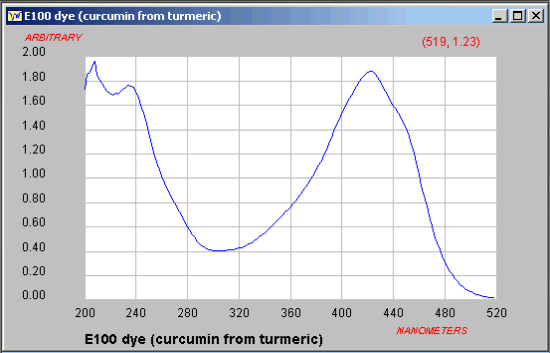
EEC code E100 (screen from JSpecView)
It is a robust, perennial, tropical herb of the ginger family
and like ginger has a thick, round rhizome with short blunt
"fingers".
In some ways, it has been compared to saffron, since not only
does it act as a spice, but it affords a fluorescent
yellow-coloured extract of a mixture of three dyestuffs,
including curcumin
which has been known for many centuries to give a rich colour to silks and cottons. The indicator properties of turmeric were noted by H.A. Vogel in 1815
The other two pigments are demethoxycurcumin and
bisdemethoxycurcumin which have one or both methoxy groups
missing from the aromatic rings.
More recently, with the advent of synthetic dyes, the role of
turmeric as a colouring material has been reduced, although
curcumin is still used as a source of colouring material in
foodstuffs such as mustard, rice, margarine, butter, cheese,
confectionery (candies) and liqueurs.
Curcumin is insoluble in water, although metal complexes with
tin or zinc are soluble.
For spectral files of other dyes in confectionery see the site
at
The University of Eastern Finland.
The most outstanding use of turmeric is as an important component of curries, to which it not only imparts a vivid yellow colour but adds a distinctive pungent flavour.
Since turmeric is extremely sensitive to light, for this reason curry powders should be stored in the dark.
A novel use caught my eye.
A source at the Colombo Observatory, quoted in the Sri Lanka
Daily News, advised people who intended to watch the partial
solar eclipse on Tuesday 24th Oct 1995, that they should add a
bit of cow dung or turmeric powder to water basins prior to
watching the sun's reflection, since this would protect their
eyes.
 Return to Chemistry, UWI-Mona,
Home Page
Return to Chemistry, UWI-Mona,
Home Page
Copyright © 1995-2014 by Robert John Lancashire, all rights reserved.
Created and maintained by Prof. Robert J. Lancashire,